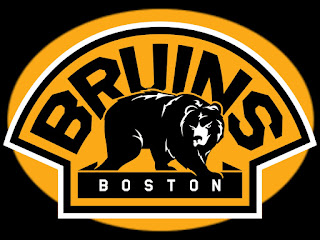On Saturday,
I was watching the Boston Bruins play and began to think about the force needed
to accelerate the puck during a slap shot. So, I went and did some research on
slap shots. According to the Guinness World Records the fastest slap shot that
was recorded in a competition was done by Denis Kulyash of Avangard Omsk in the Continental Hockey League's All-Star
skills competition in St. Petersburg, Russia, on 5 February 2011. This shot was
clocked to be traveling at 110.3 mph or 49.3 m/s. Although this is the record,
I am sort of biased towards the second-place holder Zdeno Chara of the Boston
Bruins, who set the record during the National Hockey League's All-Star skills competition
in Montreal on 25 January 2009 with a shot clocked at 105.4 mph. Either way both shots produce a hockey puck
that is moving incredibly fast. To find the acceleration that puck experiences I
started by describing the interaction as an elastic collision. The average mass of a hockey puck is 170 g or
.17 kg. The average mass of a new composite hockey stick is around 450 g or
.45kg. The final velocity of the hockey stick is 3m/s. Using the conservation
of momentum equation, you calculate the velocity of the hockey stick in the
collision.
(Mp) (Vpuck intial) + (Ms) (Vstick intial) = (Mp) (Vpuck
final) + (Ms) (Vstick final)
0 + (.45) (Vsi) = (.17) (49.3) + (.45) (3)
Vsi = 21.62 m/s
Then by finding the impulse you can solve for the force. The
collision lasted for .001 seconds.
Change in momentum = sum of forces x change in time
(.17) (49.3)/.001 = 8381N
Then if you take that force and divide it by the mass of the
puck you can find the acceleration that is experienced by the puck
8381N/.17kg = 49300 m/s2 or 5030.6 times gravitational force (g)
Overall, there is both a crazy amount to force and
acceleration.
*In this situation, I am not considering the flex of the
stick.

No comments:
Post a Comment
Note: Only a member of this blog may post a comment.